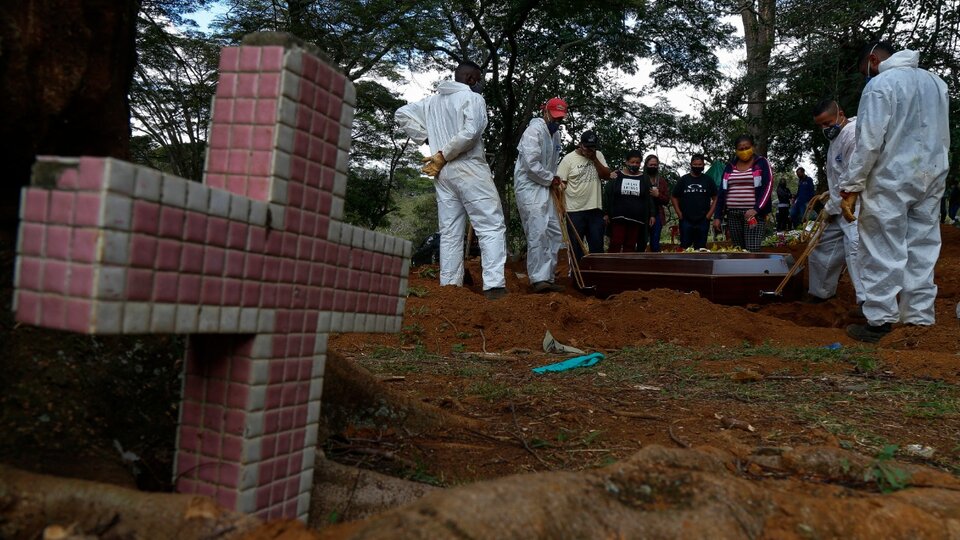
[ad_1]
In nearly three decades of work, the oldest gravediggers at Sao Paulo’s largest cemetery remember having carried out less than 10 nightly burials. But since the second wave of the pandemic in Brazil has worsened, this exception has become the rule.
The dizzying increase in cases and deaths in Sao Paulo in recent months has forced the town hall of the richest and most populous city in the country to adapt its funeral plan to avoid a collapse: in addition to recruiting more staff and vehicles to meet demand, they were allowed to work at night in four of the 22 municipal cemeteries, where every day 600 graves are open.
One of these is Vila Formosa, the largest in Brazil and Latin America, and one of the postcards of the deadly cost of the pandemic in Brazil, where more than 360,000 people have already died from covid-19.
At six in the afternoon, the changing of the guard takes place and the two huge lamps powered by generators are lit which illuminate the graves and permeate the place with the smell of diesel. It’s early fall and in this tree-lined cemetery on the outskirts of Sao Paulo, the temperature is around 16 degrees.
Eight gravediggers dressed in white overalls, masks and gloves arrive in two vans. They descend and form a circle around the pits, with their hands behind their bodies, upside down; As a sign of respect, they observe a minute of silence. Then they go get the shovels and load the first deceased of the night. “Are there no parents?” Asks one of them. “No. You can bury it,” replied another with the deceased’s documents in hand.
In May 2020, during the first wave of the pandemic, the cemetery incorporated three excavators to open 60 pits per day. Now, there are six machines that dig 200 pits a day, say the gravediggers, who extend their work until 10 p.m. They also hired about 50 vans to load the bodies because the burial cars were not sufficient. The town hall denies that school transport vehicles are part of this park, a version widely circulated in local media.
More than 300 burials per day
Shortly after, a van arrives with another drawer. A large group of relatives surround the grave where the 57-year-old man will be buried, whose file indicates he died of covid-19. The sons of the deceased ask to place a “verdeamarela” jersey of the Brazilian team on the coffin. “It’s the only thing we can do,” said the gravedigger holding the funeral documents enthusiastically.
Four men begin to deposit reddish sand on the coffin which, in a few seconds, is covered. Cries of pain mingle with the sound of shovels and the hum of electric generators.
Already used to the presence of journalists and photographers, the gravediggers discuss but ask not to be identified. Almost all vaccinated, they say the pandemic has affected administrative staff at funeral homes more than those who have worked like them in open spaces. “I wanted this to end quickly because it’s very sad. We try not to get excited about our work, but it’s sad, it’s been a lot of people, for a long time, ”said one of the gravediggers as they took off. a pair of green gloves at the end of his watch.
Vila Formosa shelters more than 1.5 million corpses on its 750,000 m2. In March, it peaked with 105 burials in a single day, three times the pre-pandemic average.
On March 30, the city of Sao Paulo set a record by burying 426 people in a single day. The experience has not been repeated since then; the current average is 391 deaths and 325 burials per day. The mayor’s office warns that if the daily average exceeds 400 burials, it will take new measures, even if it excludes the Vila Formosa starting to operate 24 hours a day.
The city council analyzes the construction of a vertical cemetery in the eastern area, while the blocks of Vila Formosa fill up quickly.
The gravediggers calculate that in 12 months, they have already used 26 batches, an area which, in the pre-pandemic era, would produce more than two years of burial. “There is room to continue here,” said one of the men. “Now at this rate, I don’t know how long it will be.”
.
[ad_2]
Source link
 Naaju Breaking News, Live Updates, Latest Headlines, Viral News, Top Stories, Trending Topics, Videos
Naaju Breaking News, Live Updates, Latest Headlines, Viral News, Top Stories, Trending Topics, Videos